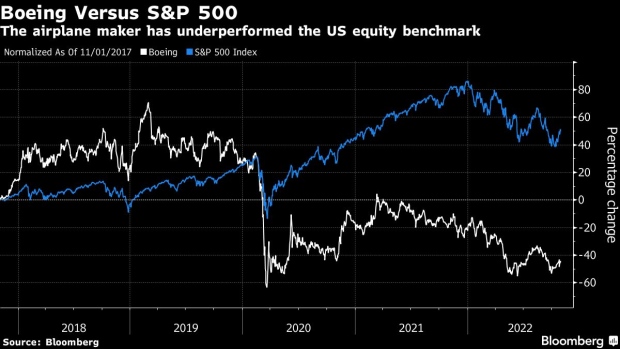Oct 31, 2022
Boeing Finally Faces Investors in Seattle After Years of Setbacks
, Bloomberg News

(Bloomberg) -- The thinking behind Boeing Co.’s investor meeting, first floated six months ago, was that by now the planemaker would be through the worst of its years of tumult, settling into a steady operating cadence and ready to offer a long-term strategy and financial targets.
This week, analysts and investors finally head to Seattle to tour Boeing’s 737 plant and meet with executives. And the situation at the US planemaker is anything but normal.
Even after restarting long-halted 787 Dreamliner deliveries in August, the beleaguered titan is still racking up losses. It’s no closer to resuming 737 Max deliveries to China, a milestone critical to improving its finances. The final two Max models still haven’t won regulatory approval.
Nevertheless, Chief Executive Officer Dave Calhoun, Chief Financial Officer Brian West and other business leaders are expected to provide the first meaningful guidance since early 2019, when two 737 Max crashes plunged the company into crisis. Getting Wall Street to buy into Calhoun’s vision for Boeing is another matter.
“Right now, investors don’t believe them,” said Ron Epstein, an analyst with Bank of America. “There’s a crisis of credibility in the investment community that they have to bridge.”
Boeing didn’t miss Wall Street’s consensus earnings estimates from July 2016 through January 2019 -- but has only met or exceeded them three times since then. The planemaker’s finances and operations were battered when the Covid pandemic flattened airplane sales shortly after Calhoun took over as CEO in 2020, and more recently it has grappled with shortages of engines and skilled workers.
The company’s shares have dropped 29% this year, compared with an 18% drop in the S&P 500 index. The stock is headed for its third consecutive year of declines. Since the end of 2019, Boeing’s market value has dropped by more than half, to $85.7 billion -- just below its archrival Airbus SE.
Last week, the company revealed a surprise, $2.8 billion defense charge and lowered its 737 delivery target. The CEO has been criticized for his hands-off management approach, and frustrations have grown as rival Airbus widens its market lead.
For analyst Rob Stallard of Vertical Research Partners, the company’s woes are like a “whac-a-mole” game, with fresh problems cropping up as others are resolved.
“Given the track record to date, particularly on forecasting additional defense charges, we continue to be wary of whatever outlook Boeing provides,” Stallard wrote to clients last week.
Boeing hasn’t held a regular investor conference with streamed presentations from its three business chiefs since May 2016. Under former CEO Dennis Muilenburg, who was ousted for his handling of the 737 Max tragedies, the planemaker suspended the investor sessions while it dominated the Dow Jones Industrial Average as a seeming financial juggernaut with a prodigious free cash flow.
For many investors, the two-day event beginning Nov. 1 will provide the first introduction to a phalanx of new executives who’ve taken on senior roles since Boeing last held a behind-doors mixer for the financial community five years ago.
The best case would be for Boeing executives to outline a range of scenarios for mid-decade, when production of the cash-cow 737 and 787 should be back in high gear -- while providing a healthy dose of reality about the risks, Epstein said in an interview.
Boeing is finally starting to generate cash. Epstein predicts a relatively modest $700 million cash gain this year could jump to $12.4 billion by 2024 if the company is able to get 737 Max production on track and defense costs under control.
“Truth is, it will still take time to normalize,” Calhoun said on Boeing’s Oct. 26 earnings call. “Our objective in the investor conference that lies ahead is to give you that projection as to how and when we think that is likely to happen.”
Boeing startled the market last week by disclosing its defense business won’t make money this year or next, even as rising defense budgets boost other military contractors.
But for Robert Spingarn, an analyst with Melius Research, the real shock was the revelation that Boeing is only building about 21 or 22 of its 737 jets each month, about one-third fewer than analysts had modeled. He expects investors to stew over this discrepancy between production and delivery rates ahead of Boeing’s Nov. 2 presentations.
“They very quietly and confusedly move the goal posts to the low 20s,” he said of the 737 monthly output in an Oct. 28 interview. “That’s one of the key focus points going into next week.”
--With assistance from Nancy Moran.
©2022 Bloomberg L.P.






